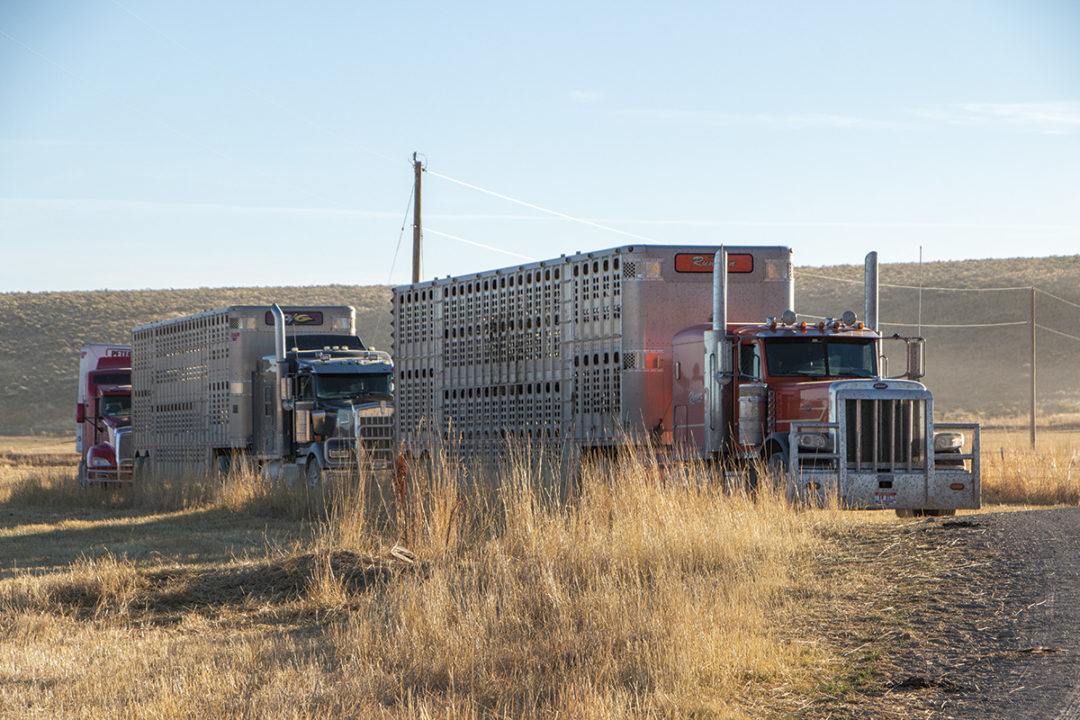Rod Runyan, of Rod Runyan Trucking and Farms of Buhl, hauls cattle and alfalfa hay. “Over the years, I’ve hauled everything from fish feed to lumber,” Runyan says.
When asked what problems are facing trucking today, Runyan says, “Expenses mainly – fuel prices, insurance, tires – everything is expensive. Government regulations aren’t helping either. To haul livestock, you need a CDL-A endorsement and a livestock trailer. There are not a lot of new guys coming in. Not a lot of people want to work that hard or invest the time and money it takes to do it.
“It takes a long time to get where people trust and use you. I’ve done it for 25 to 30 years. A lot of people use the new guys because they won’t charge as much, but then you get what you pay for. A lot of guys don’t have insurance for the cattle or their equipment. If the floors are slick, cattle will go down in the trailer or not be able to stand for the ride or trip. It takes a lot of experience to get to where I’m at,” Runyan says.
“It’s tough to find anybody that’ll be on time and care. There are not a lot of guys that do the beef hauling. Not very many of them have more than one truck. It’s hard to find good help that you can trust or that have experience with animals. Every load is different – weather, time, places, cattle numbers – loads are never the same.”
Runyan usually drives in northern Nevada, Utah, Wyoming, Montana, Oregon and California. “Wherever they want to go is OK with me,” he says.
 The truckers and ranch crew collaborate on the shipping plan before loading begins. Photo by Lynn Jaynes.
The truckers and ranch crew collaborate on the shipping plan before loading begins. Photo by Lynn Jaynes.
Runyan’s off-season is during the summer months and deep winter. “It’s a little slow now. It just started slowing down in January, but I run year-round, not heavy. I do farming and custom hay, so I don’t have to work as much. I need to work more than I do, but sometimes I have to stay home [to farm].
“I bought my first truck when I was 17 or 18, then I sold the truck so I could farm,” Runyan says. He started farming when he was 20 at Roseworth. With his dad, Charley, Runyan worked off and on driving trucks for other people when he first started farming to bring in additional income. He didn’t want to haul steady. “I farmed, I needed to be a little flexible.” Runyan farms grass and alfalfa hay, corn, grain and barley, and he has a small cow herd. “My wife, Jamie, does most of that when I’m gone, but I try to stick around to help out,” he says.
Runyan says he would like to sightsee more when driving truck, but he finds it difficult to do. "I’d have to go back, and there’s so much traffic now. I drive probably a little faster than I should, so I have to pay attention to the road and what’s going on around me.” If cattle are going to sell at a feedlot, producers want them there immediately. "They don’t want to lose more weight on their animals, so I have to hurry right along,” he says. Runyan comes home empty sometimes, but he rarely gets a load of cattle back.
He has two daughters and five grandchildren, ages 3 to 22. “The grandkids go a lot. And that can keep me on my toes,” says Runyan.
Runyan says, “I’ve never had a contract to haul. People just call me, and it's spread by word of mouth. I do a lot of sale yards, but I’ve been doing it for so long that people call me, and friends refer me.
“I’ve done one load this week, but I usually do four or five loads a week, sometimes more. I never know, I just sit and wait for the phone to ring. I’ve got a few loads booked in advance. The cattle are all moved off the range, and others are taking them to the sale right now. There’s not much going on,” he says.
According to the Idaho Transportation Department, all vehicles with livestock must stop at an Idaho port of entry for inspection. This deters theft, controls the spread of disease, and ensures trucks and trailers transporting livestock meet Idaho’s vehicle safety standards. Failure to stop could result in a citation and a considerable loss of time.
To enter Idaho with cattle, transporters must have the following: a certificate of veterinary inspection, brucellosis vaccinations on all females over 4 months old, negative trichomoniasis tests on all intact males over 18 months old, negative tuberculosis tests on dairy cattle and cattle used for rodeos or timed events, an entry permit for certain classes of cattle, brand inspections, registration certificates or bills of sale and individual official identifications. There may be other permit requirements.
The USDA National Agricultural Library states, “If livestock are being transported for longer than 28 consecutive hours, they must be offloaded for at least five consecutive hours to get feed, water and rest. The USDA enforces the law.”
 It’s not just a cattle truck ready at the loading chute. It’s a clean cattle truck, for Rod Runyan, that separates the professional haulers and shows a higher level of care. Photo by Lynn Jaynes.
It’s not just a cattle truck ready at the loading chute. It’s a clean cattle truck, for Rod Runyan, that separates the professional haulers and shows a higher level of care. Photo by Lynn Jaynes.
But Runyan says, “Twenty-four hours is about the most I’ll let them stay on my truck. It’s tough for one guy to drive that long. I can drive to California in 14-16 hours, or 18 hours occasionally.”
When asked about sanitary practices, Runyan jokes that he washes his hands. “I clean my truck out as often as I can. If I can’t wash it, I’ll broom it down good. I use a lot of sawdust to keep the cattle or calves that I haul dry. While it’s not a requirement, some people request it. It’s just a habit. I try to clean it every time if I can get to a washout or here at the house. Some guys won’t do that, but it just depends on who you ask or call to haul or hire. That’s why I stay busier than most. It's because we keep them clean," he says.
Runyan says he works with about six or eight other truckers. “If we get more than one load, we share loads back and forth.” He only has one truck and says it works better for him that way.
“I’m ag proud because I’m proud of what we do. And I respect the people I get to work with, the crops raised and the cattle we haul, whether they’re ours or somebody else’s. I enjoy it. I’ve done other things, and it’s not nearly as enjoyable. But mainly, I’m ag proud because the people in cattle and agriculture are the backbone of America,” Runyan says.



.jpg?t=1687979285&width=640)




